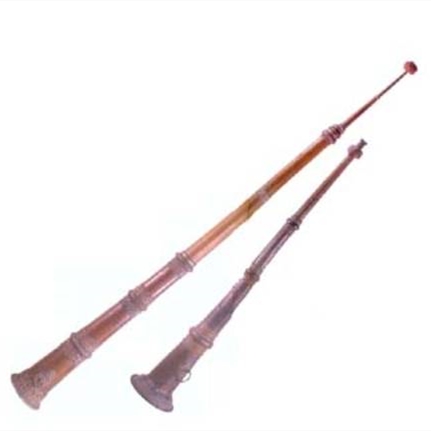Tong Qin's playing method
Tongqin is also known as "mang tube", "copper winter", "copper hole", "big copper horn" and so on. "Tongqin" in Tibetan means a large size. The Mongolian people call it "Bili", and the Chinese call it a large tube, a long horn, and a small copper horn. It is a very important bass instrument in Lamaist bands. This musical instrument has a history of at least 700 years in Tibetan areas. It was first introduced to Inner Mongolia along with Lamaism in the second half of the 16th century.
Tongqin is played by trained lamas. When playing, one end of the trumpet is placed on the ground or on a wooden frame, and the player holds the upper end of the instrument with both hands. Tong Qin has his own repertoire. Tong Qin's tone is deep and rich, and it sounds quite solemn and majestic. In Tibetan Buddhist monasteries in Tibetan and Mongolian areas, there are some well-trained playing monks.

Because the tongqin tube is long and thick, the playing is laborious and difficult to control, so the cyclic ventilation method is often used to play. Each tube can emit three tones, namely the fundamental tone (the first overtone of the pipe), the second overtone of the upper fifth and the fundamental tone of the lower octave, and sometimes a glissando with a major third falling from the fundamental tone. . The volume is loud, and the tone is rough and low, which makes people feel eerie. Tongqin in various monasteries has different pitches, and the basic sound generally ranges from F to B. Each monastery has at least one pair of tongqin, and larger monasteries have two or three pairs or more (uniform pitch). It is often used in religious activities such as chanting and Qiangmu or playing on the eve of festivals, and two are often used to play at the same time. In Tibetan areas, they often play together with Jialing, and Tongqin plays the long tone as an auxiliary part. Sometimes they often play together with Jialing, Shengu, Buzai and other musical instruments.
At present, in the Drepung Monastery and Jokhang Monastery in Lhasa, Tibet, there are still extremely precious Tongqin music scores, which are called Yangyi in Tibetan. The special music often played include "Egangha Festival" and "Janes". The former is a piece of music played by monks on the roof on the eve of a religious festival, indicating that the festival is about to begin. The latter is a piece of music praising Guanyin Bodhisattva. In secular music activities, Tongqin is used in the performance of the Tibetan opera troupe affiliated to the monastery.
 渝公网安备 50010702504639号
渝公网安备 50010702504639号